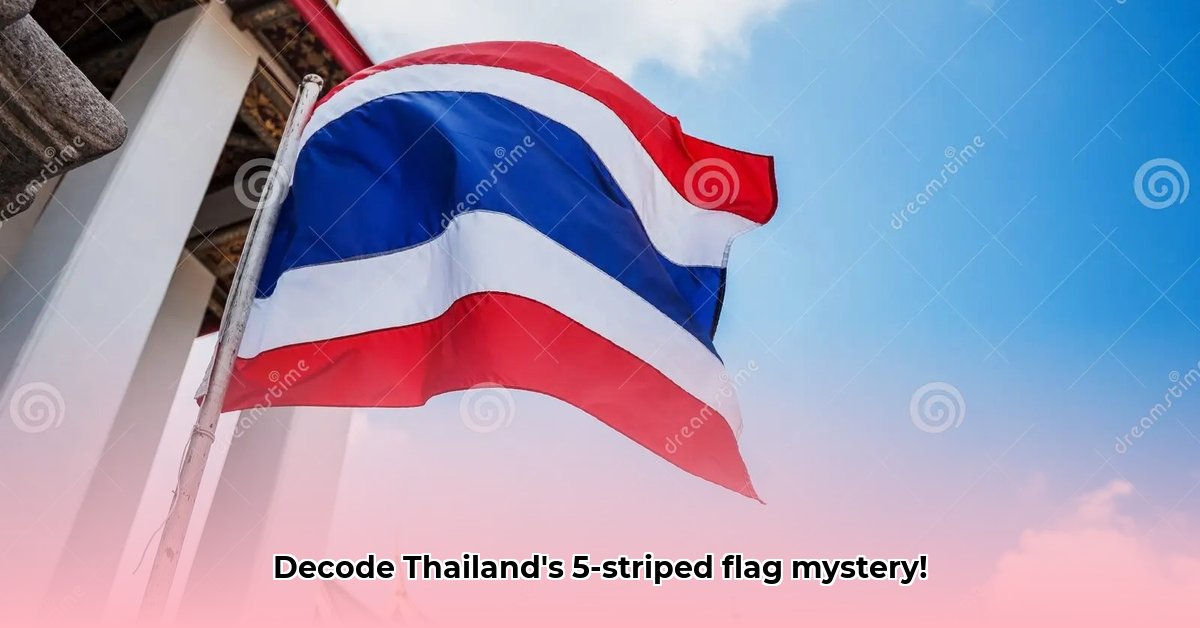
Hoeveel Strepen Vlag Thailand?
So, you're lekker curious about the Thai flag, is dit nie? Those five horizontal stripes – red, white, blue, white, red – are more than just a pretty picture; they tell a lekker story of Thailand's history and its national identity. This isn't a quickie; we're diving deep into the colours, the design, and the historical moments that shaped this iconic symbol. We'll unpack what each colour represents – things like the nation, religion, and the monarchy – and explore how the flag's design evolved over time. Get ready for a fascinating journey into the heart of Thailand, one stripe at a time!
More Than Meets the Eye: A Simple Design with a Deep History
The Thai flag's design is deceptively simple: five horizontal stripes—red, white, blue, white, red—with the central blue stripe slightly wider. But this unassuming appearance belies a rich tapestry of meaning, reflecting centuries of Thai history and national identity. Officially adopted in 1917, it's celebrated annually on September 28th as a powerful symbol of Thai nationhood. Did you know that the subtle differences in stripe width are also significant components of its symbolism?
Decoding the Colours: Different Views, Shared Pride
What do the colours mean? This is where it gets regtig interesting. The most common interpretation links them to the national motto: "Nation, Religion, King." However, interpretations vary. Some see red representing life, white representing Buddhism, and blue representing the monarchy’s power. Others say red and white represent the land and its people, with blue maintaining its royal association.
Why the differing views? These variations likely reflect changing perspectives and evolving interpretations over time. The beauty of symbolism lies in its capacity for multiple meanings, enriching its complexity and resonance. The regte meaning is perhaps not a singular, definitive answer.
The Big Blue Stripe: A Royal Statement
That prominent central blue stripe is a powerful visual statement about the monarchy's significance in Thai identity. It's a potent visual reminder of the deep-rooted connection between the royal family and the nation. The flanking red stripes likely represent the nation's strength and the spirit of the Thai people. The white stripes, nestled between, could symbolize purity, the Buddhist faith, or the ideals Thais aspire to. Again, interpretation remains open to debate.
King Rama VI and the World Stage
The 1917 adoption of this specific design wasn't arbitrary. King Rama VI, reigning at the time, made a calculated choice, influenced by both national symbolism and international politics. His decision subtly signaled opposition to Germany during World War I. This highlights how national symbols are rarely created in isolation, reflecting global events and political realities.
A Living Symbol, Constantly Present
The Thai flag isn't a relic of the past; it's a vibrant, ever-present symbol. It’s proudly displayed on buildings, waves at ceremonies, and even adorns clothing. This constant visibility ensures its meaning remains relevant and alive in the daily lives of ordinary Thais. It's not just a static image, but an active participant in Thai national life. How often do you see it displayed in your community, and what does it evoke in you?
Still Unfolding: An Ongoing Conversation
The precise meaning of the Thai flag's colours and stripes remains an ongoing conversation and subject of scholarly debate. Its symbolism continues to evolve alongside Thai society, reflecting the nation's changing landscape while preserving its core values. The flag remains a powerful and evocative image, a vibrant representation of a nation’s rich history and enduring spirit. Its meaning is ultimately something each Thai person reflects upon individually.
How Thai Flag Symbolism Evolved Over Time
Key Takeaways:
- The current Thai flag's design was solidified in 1917.
- Its colours hold layered symbolic meanings: red for the nation, white for purity and Buddhism, blue for the monarchy.
- The flag's evolution reflects changes in Thailand’s political landscape and global relations.
- Early Siamese flags were less standardized, leaving much room for scholarly interpretation.
- Further research is needed to fully understand the flag’s pre-1917 history.
From Humble Beginnings to National Pride: A Look at Early Thai Flags
Before the familiar red, white, and blue, what did the Thai flag look like? Historical records on early Siamese flags are unfortunately fragmented. We know flags existed, but precise designs and symbolism remain largely a mystery to historians. Available information points to far simpler flags, often with a single colour, usually red. It’s a fascinating area for further research and interpretation.
The Birth of the Tricolour: 1917 and the Modern Thai Flag
The adoption of the current tricolour in 1917 marked a pivotal moment. This was more than a mere design change; it signified Thailand’s growing global presence and its evolving political identity. The design—red, white, and blue horizontal stripes, with the blue stripe twice as wide—mirrored international norms while retaining distinctly Thai elements. The design was a smart, deliberate move.
Decoding the Colours: Symbolism and Sovereignty
The colours are not arbitrary choices; they are imbued with deep symbolic significance. Red represents the nation and its people—their strength, resilience, and unity. White, a symbol of purity and closely associated with Buddhism, speaks to the nation's deep-seated spirituality. Blue, traditionally linked to the monarchy, represents the enduring role of the royal family in Thailand's history. These colours are more than just aesthetics; they are potent symbols of national pride and belief. What aspects of Thai culture do these colours reflect in your opinion?
How Thai Flag Symbolism Evolved Over Time: A Reflection of National Identity
The evolution of the Thai flag isn't merely a matter of visual changes. It serves as a compelling mirror, reflecting shifts in the nation’s self-perception, its engagement with the global community, and its enduring values. It encapsulates Thailand's journey, a visual narrative of its history, beliefs, and aspirations. The flag's story is a compelling journey that continues to resonate today.